Landslide - Geoscience Australia
Landslide - Geoscience Australia
Landslide - Geoscience Australia
Create successful ePaper yourself
Turn your PDF publications into a flip-book with our unique Google optimized e-Paper software.
in their municipalities, although the data are<br />
difficult to retrieve once they have been lodged<br />
with a regulator. There is seldom incorporation<br />
of, or reference to, these geotechnical reports in<br />
landslide databases and landslide information is<br />
rarely synthesised across multiple jurisdictions.<br />
If this information was made easily accessible<br />
to those who undertake risk analysis, it could<br />
significantly improve the availability of the basic<br />
knowledge required to assess landslide frequency<br />
and occurrence. Additionally, successive<br />
investigations in one vicinity would be able to<br />
build on previous research.<br />
<strong>Landslide</strong> Susceptibilty Mapping<br />
The distribution of landslides in the <strong>Australia</strong>n<br />
landscape is not well known. There has never<br />
been a national landslide susceptibility or hazard<br />
(likelihood) mapping programme, and only<br />
limited nationwide studies of landslides have<br />
been conducted.<br />
It is difficult to assess landslide susceptibility on a<br />
national scale, because landslides are dependent<br />
on the interaction of localised conditions, and<br />
methods to overcome the data limitations<br />
are still being developed. <strong>Landslide</strong> mapping,<br />
when conducted, generally occurs only on a<br />
site-specific scale and is performed by geotechnical<br />
consultants for purposes of zoning, building<br />
infrastructure or applying for development<br />
approvals.<br />
The regional susceptibility mapping of areas<br />
prone to landslides is not commonly undertaken<br />
in <strong>Australia</strong>. Without regional mapping, it is<br />
difficult for those with regulatory responsibilities<br />
to be aware of any landslide risks within their<br />
jurisdictions and target areas for detailed mapping.<br />
Examples are provided in Ezzy and Mazengarb<br />
(2007), Miner and Dalhaus (2006), and in a<br />
Victorian Government report regarding the Alpine<br />
Resorts Planning Scheme (DSE 2007a).<br />
First-pass landslide susceptibility maps are<br />
needed, particularly across areas with known<br />
histories of landslide occurrence. The limitations<br />
of the mapping and the levels of accuracy need to<br />
be made explicit on such maps.<br />
The availability of relevant datasets, such as<br />
geomorphology at scales of 1:25,000 or better,<br />
is highly variable throughout the country, even<br />
when considering the major urban areas. Highresolution<br />
data are essential for undertaking<br />
susceptibility, hazard and risk analyses in<br />
localised regions.<br />
Fundamental research directed at better<br />
understanding landslide processes in the<br />
<strong>Australia</strong>n setting is currently very limited.<br />
There are also significant geomorphic research<br />
gaps which include measuring the age of <strong>Australia</strong>’s<br />
landscape and developing landscape evolution<br />
models which can contribute significantly to<br />
better appreciation of slope-forming processes<br />
and their associated process rates.<br />
<strong>Landslide</strong> Hazard Mapping<br />
The primary constraint to hazard mapping is<br />
a lack of good inventory maps and validated<br />
inventory databases, in addition to resource<br />
constraints.<br />
There is a need for systematic and standardised<br />
landslide hazard assessments throughout the<br />
country, in order to assist stakeholders, such as<br />
regulators, to be aware of landslide hazards and<br />
to make informed land use decisions. Emergency<br />
management agencies would also benefit from<br />
acquiring a more technical understanding of<br />
landslide hazard areas to inform the development<br />
of emergency action plans.<br />
Determining temporal probability is often not<br />
possible, because of the absence of historical<br />
landslide records which can be related to the<br />
historical records of triggering events, the<br />
scarcity of input data, or the insufficient length<br />
of historical records of triggering events (van<br />
page 126 | NATURAL HAZARDS IN AUSTRALIA | Identifying Risk Analysis Requirements

















